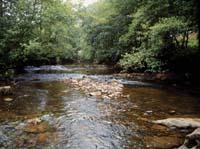2007/01/01
227. zenbakia

eu es fr en cat gl
Aparecerá un contenido traducido automáticamente. ¿Deseas continuar?
Un contenu traduit automatiquement apparaîtra. Voulez-vous continuer?
An automatically translated content item will be displayed. Do you want to continue?
Apareixerà un contingut traduït automàticament. Vols continuar?
Aparecerá un contido traducido automaticamente. ¿Desexas continuar?
Taking the pulse to the rivers
Text created by automatic translator Elia and has not been subsequently revised by translators.
Elia Elhuyar
When conducting river studies, it almost always focuses on the structure of the ecosystem (what, where and how much). But it is so important to know if the river really works well or whether it is healthy or not. Something similar happens when we take the car to the workshop. That is, in addition to the parts being well, that car has to walk.
Taking the pulse to the rivers
01/01/2007 | Kortabitarte Egiguren, Irati | Elhuyar Zientzia Komunikazioa

(Photo: UPV)
There may be living beings in the rivers and the river is apparently healthy. It is certainly a representative data. But if the state of the river is analyzed, in some cases it is observed that it breathes immediately. In this sense, the Department of Plant Biology and Ecology of the UPV/EHU, in collaboration with the Department of Languages and Computer Systems, analyzes the functioning of rivers. In fact, they study the metabolism of several rivers of Gipuzkoa and Bizkaia. They measure the production and consumption of oxygen concentration in rivers by balancing oxygen between photosynthesis and respiration. To do this they use the data of 21 stations managed by the Provincial Council both in Gipuzkoa and in Bizkaia. These stations measure river flow, oxygen concentration, temperature, pH, etc. every 10 minutes. Subsequently, all these data are passed monthly to UPV researchers.
Data processing
In addition to the information passed by the Provincial Council, they periodically address these rivers performing water analysis, sampling and other tests. All this data is then processed. To do this they have developed a computer system: Rivermet. Basically, they see how the oxygen concentration changes from day to night, in several curves represented on an Excel page. UPV-EHU researchers have managed to deal with and work with a large number of data relatively automatically, and it is not a simple task.
This developed computer system allows to visualize in a very integrated way the operation of all the rivers and to carry out an exhaustive monitoring of the same. They get the same information as about one inch.
But there is a small problem: determine the normal state of the river. At the moment this has been investigated little worldwide and it is not very clear when it can be said that the state of the river is normal and when it is violated. That is, critical levels are not somehow consolidated. There are very orientative values.
The computer tool developed by UPV/EHU researchers opens the doors to learn more about this aspect. In fact, it allows to analyze at all times the simultaneous operation of all rivers. Once you have a lot of data of this type, you will know more clearly what the critical level is. For example, the situation of the Deba River is worrying, but if we begin to improve, when can we know that it has gone from black to white? The tool will help solve these and other cases.

River Lea in Oleta. The good quality of both water and its habitat makes this river a reference for knowing the metabolism of natural rivers.
UPV/EHU
Respite
The results show that in the Basque Country rivers continue to have high levels of pollution. Yes they have improved, most have fish. However, significant variations in oxygen concentration in river metabolism have still been observed in some cases.
Now they want to know what are the factors that most influence metabolism. They know, among other things, that the shape, light and temperature of water courses influence. In fact, photosynthesis and respiratory processes do not occur in the same way in channeled and non-channeled rivers.
Whether or not the river has forests beside it. In rivers with few forests on their shores, the water is very hot in summer. Reduces the presence of oxygen and facilitates access to anoxia status (lack of oxygen). In fact, despite the high production of oxygen, the amount of oxygen consumed in photosynthesis is also high due to the large number of living beings. Therefore, especially at night, they are easily accessible to the state of anoxia. In the gloomy rivers, on the contrary, hardly light reaches the river, so there are usually no large productions.
Therefore, in addition to knowing what fish and how much is in the rivers, it is very interesting to know how the water breathes to study the ecosystem in its entirety.
Project overview
The Provincial Councils of Gipuzkoa and Bizkaia continuously analyze the quality of some rivers. With this data, and through software developed for this purpose, we continuously measure the photosynthesis and respiration of river ecosystems. In this way you can monitor the functioning of the rivers, know the environmental factors that control it and see if human activities affect them.
Director
Arturo Elosegi.
Working team
A. Elosegi 1, J. Well 1, M. Bermejo 2, J. 1 and O. Izagirre 1.
Department
1 Plant Biology and Ecology and 2 Computer Languages and Systems.
Faculties
1 Science and Technology and 2 Informatics.
Financing
Ministry of Education and Science.
Working group page
http://www.ehu.es/streamy/.

On the left, Arturo Elosegi, Miren Bermejo and Oihana Izagirre.
(Photo: UPV)
Kortabitarte Egiguren, Irati
Services
227
2007
1.
038
Universities
Dissemination of knowledge
Other








